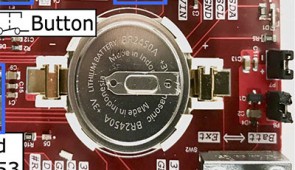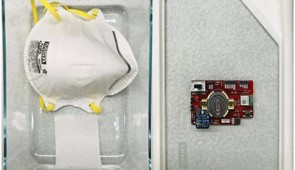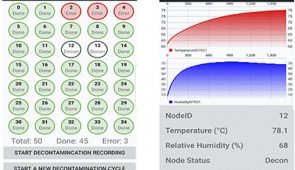Sensor takes guesswork out of N95 decontamination
Wireless system can sense when masks are properly decontaminated in moist-heat
- Link to: Northwestern Now Story
- Moist-heat is promising for sanitizing masks for reuse but unreliable in ovens without uniform heat
- New sensors track temperature and humidity for each mask in an oven
- Users can monitor hundreds of individual masks via a smartphone app
- One sensor is about the size of a quarter and costs $15 for 1,000
- Designs are available on N95DECON scientific consortium
EVANSTON, Ill. — For moist-heat decontamination to properly sanitize N95 facemasks, the conditions have to be perfect. If the temperature or humidity are even the slightest bit too low, then dangerous pathogens can survive the process, putting mask-wearers at risk for infection.
Researchers at Northwestern University, University of Michigan and University of Florida have developed a new wireless sensor platform takes the guesswork out of decontaminating N95 facemasks. By sensing temperature and humidity and tracking time, the inexpensive sensor ensures that conditions are ideal for decontaminating masks.
The researchers tested the platform, called VeriMask, in the laboratory as well as in real clinical settings. The sensor was able to ensure proper decontamination conditions for hundreds of masks simultaneously, while users monitored the process in real time with a smartphone app.
“Right now, there is no way to know if the mask was properly decontaminated,” said Northwestern’s Josiah Hester, who co-led the research. “Because of the N95 mask shortage, healthcare workers just have to reuse their masks and hope for the best. We wanted to make a more scientific platform capable of verifying proper decontamination.”
Hester and his collaborators recently shared VeriMask’s designs and schematics with N95DECON, a scientific consortium that reviews, collates, publishes and quickly disseminates data-driven research on N95 decontamination.
Earlier this year, the research won a “Best Poster Runner Up” award in a special session on COVID-19 Response Research at the Association for Computing Machinery (ACM) Conference on Embedded Networked Sensor Systems.
Hester is an assistant professor of computer science and electrical computer engineering at Northwestern’s McCormick School of Engineering. He co-led the work with Kevin Fu, an associate professor of computer science and engineering at the University of Michigan and principal investigator of the National Science Foundation award supporting the work. Sara Rampazzi, an assistant professor of computer and information science and engineering at the University of Florida, also was a key contributor to the work.
The ongoing personal protective equipment (PPE) shortage has challenged frontline workers to find new, reliable ways to decontaminate and reuse N95 facemasks. Because it can use ovens already available in hospitals and potentially sanitize hundreds of masks at a time, the moist-heat decontamination process has emerged as one of the most-promising methods for resource-strapped hospitals.
“The alternative is ultraviolet light decontamination, which requires expensive custom equipment,” Hester said. “For VeriMask, you just need a smartphone and inexpensive sensors. This brings access to rural hospitals and low-resource communities, so they can safely reuse masks.”
For the moist-heat process to work, used facemasks must be exposed to over 50% humidity and temperatures higher than 70 degrees Celsius for 30 minutes in order to kill bacteria and viruses without damaging the mask itself. Although this sounds simple, there is currently no way to ensure that conditions are uniform across an entire oven.
“Commercial ovens tend to have ‘hot spots’ and ‘cold spots,’” Hester said. “And every oven is different. Hospitals have everything from industrial ovens to toaster ovens. All can be used to decontaminate masks but all distribute heat differently.”
The VeriMask platform consists of two major components: a Bluetooth Low Energy (BLE)-enabled wireless sensor and a smartphone application. The sensor collects temperature and humidity data, streaming it to the app for real-time monitoring. The app notifies users when each mask finishes the decontamination process. The app also alerts users if specific masks were not properly decontaminated, so those can be disposed instead of reused.
To use the system, each mask must be put into its own oven-safe container along with a moist paper towel to generate humidity. One sensor is then placed into each container alongside the mask. Each sensor measures 3.5 centimeters by 3.8 centimeters in size and costs about one cent.
“The VeriMask platform can contribute to the healthcare community by making N95 mask decontamination faster, safer, easier and more affordable,” said Yan Long, a Ph.D. student in Fu’s laboratory. “Due to its simple setup and usage as well as low cost, it can be widely deployed in under-resourced healthcare facilities and hospitals around the world.”
Multimedia Downloads
VeriMask images
Please credit all images to Northwestern University/University of Michigan



